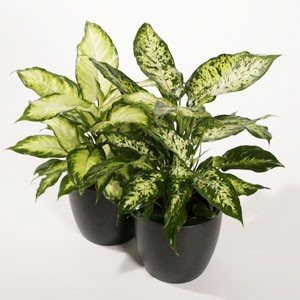
Take a closer look at those leaves
Leaf problems: Erwinia, Xanthomonas, Anthracnose, Alternaria, Botrytis, Pythium and Phytophthora to name a few of the big, bad and ugly leaf spots occasionally seen on tropical foliage plants. The many foliar leaf spots and blights that can occur on leaves of plants outdoors or in a production greenhouse will not usually be a problem on well-established plants in an interiorscape. This is because most of these tongue-twisters are the result of damp air and splashing overhead irrigation.
A fungus grows on a leaf the way mold grows on bread. Look for a circular lesion of growth. Sometimes this circular lesion will overlap another giving a more blotchy appearance. Check for concentric rings within the lesion, which gives a bulls-eye appearance. Fungus produce spores as they mature and are either transported through the air or spread by swimming in water. Powdery mildew is a common fungus spread through the air. Pythium and Phytophthora are “water molds.” It’s really quite fascinating to look at fungus under a magnifying glass. Take a look!
Bacterial leaf spots look dark-wet in appearance. The damaged part of the leaf will look water-soaked and frequently feels slimy to the touch. Yuck! Sometimes there may be a yellow halo around the spot. Bacteria do not produce spores but are spread just as easily by splashing water. The slimy leaves that are sometimes present on newly arrived Philodendron selloum are a bacterial leaf spot called Erwinia. This is especially common to see during the summer months.
More important than trying to remember names of plant diseases and bacteria is to keep a clean and healthy environment for the plants in your care. Do this by promptly removing abnormal leaves. Then, ask yourself what you know about this plant. Is it newly installed? Are you over watering it? Is there water sitting on the leaves? These various leaf spots are warning signs of leaf distress. Take heed of them and respond promptly, and you will have happy foliage in your care!
